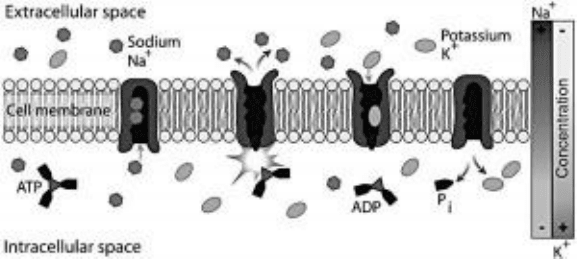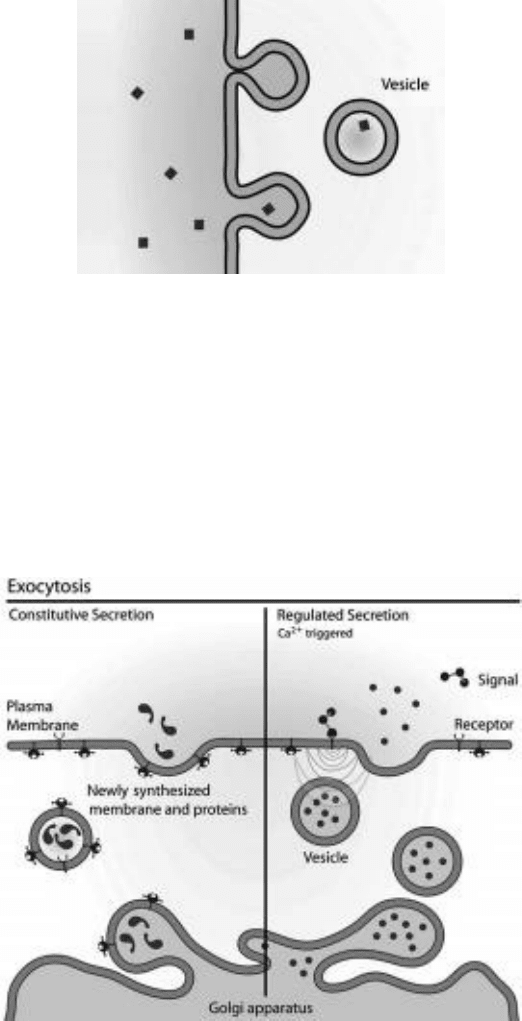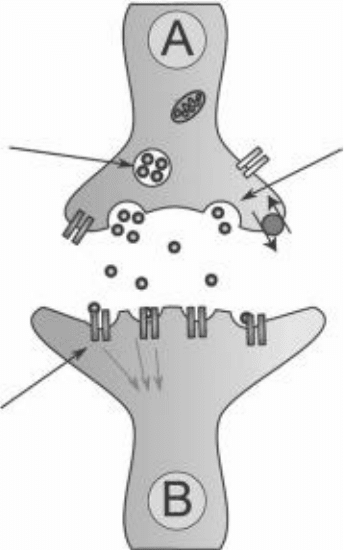Goldfarb D. Biophysics DeMYSTiFied
Подождите немного. Документ загружается.

282 Biophysics D emystifieD
negative, then the cell can solve the energy barrier problem using a passive ion
channel, as described previously. However, in some cases, especially those which
involve relatively large molecules, the cell may make use of active transport to
move the molecule into the bilayer and across.
The second and more common reason active transport is needed is because
the cell requires a higher concentration of some substance on one side of the
membrane. Purely passive transport would tend to equalize the concentrations,
until the concentration is the same on both sides of the membrane. Gibbs
energy changes are typically negative for moving a molecule from a region of
high concentration to a region of low concentration (primarily for entropic
reasons). So the Gibbs energy change favors equalizing the concentrations. This
is why moving a molecule from a region of low concentration into a region of
high concentration requires the input of energy to go against the concentration
gradient. An example of this is the uptake of glucose from digested food. The
glucose has to move from the hollow of the small intestine (where its concen-
tration is low) into the cells that line the walls of the small intestine. The cells
lining the wall of the intestine need to concentrate the glucose on their insides
and then pass the glucose into the bloodstream. Without active transport, as
soon as the concentration of glucose in the cells reached the level in the hollow
of the intestine, no more glucose would flow into the cells. A significant amount
of glucose in the digested food would be lost.
There are two types of active transport. Both are mediated by transport
proteins that are part of the cell membrane. Primary active transport takes
energy from cleaving a high energy phosphate bond and uses that energy
directly to transport a molecule or ion across the membrane. Secondary active
transport utilizes energy from concentration gradient to drive the active trans-
port; that is, the favorable Gibbs energy of some molecule moving from high
concentration to low concentration (a passive transport) is coupled with actively
pushing some other molecule across the membrane. The term secondary active
transport comes from the fact that the cell expended energy, via primary active
transport, to create the concentration gradient in the first place.
Active transport that involves transporting more than one type of molecule
or ion is called cotransport. Transport proteins that mediate the simultaneous
transport (cotransport) of more than one type of molecule or ion are called
cotransporters. Cotransporters that move the different molecules in the same
direction across the membrane are called symporters. Cotransport proteins that
move different molecules in opposite directions across the membrane are called
antiporters. Most examples of cotransport that have been studied involve only

chapter 11 MeMBrane Biophysics 283
two different molecules or ions. However, some cases of three or more have
been studied. In cases where three or more molecules are moved by a cotrans-
porter, if at last one substrate moves in the opposite direction to the others then
the cotransporter is termed an antiporter. Only if all substrates move in the
same direction do we use the term symport.
still struggling
Most books use the terms symport and antiport as defined here. however, some
books use cotransport to mean “symport,” and countertransport to mean “antiport.”
?
Primary Active Transport
In primary active transport, the transport protein couples a reaction hydrolyzing
ATP with moving the ion or molecule across the membrane. Recall from Chap. 7
that hydrolysis of ATP (adenosine triphosphate) involves cleaving one of the
phosphate groups from ATP to form ADP (adenosine diphosphate). When
the pyrophosphate bond is cleaved, a large amount of energy is released. This
energy can be used by any process that is coupled to the reaction cleaving the
phosphate bond. The coupling of a process to a reaction that involves hydroly-
sis of ATP is typically done by an enzyme classified as an ATPase, and the cou-
pling is usually carried out by some conformational change in the enzyme. In
the case of primary active transport, it is the transport protein itself that couples
the hydrolysis with transporting a molecule or ion across the membrane.
The mechanism of active transport involves a conformational change in the
transport protein. The conformational change is needed to push the molecule
(or ion) through the hydrophobic bilayer or to move the molecule (or ion)
against a concentration gradient. In primary active transport, without the
hydrolysis of ATP the conformational change is otherwise not favorable. The
enthalpy from the hydrolysis of ATP tips the Gibbs energy change in favor
the conformational change that pushes the molecule across the membrane.
The Sodium-Potassium Pump
Figure 11-12 illustrates an example of primary active transport. This example is
called the sodium-potassium pump. The term pump is used whenever a transport

284 Biophysics DemystifieD
protein actively moves molecules from a region of low concentration to a region
of high concentration. The sodium-potassium pump establishes and maintains a
concentration gradient such that sodium ions are concentrated on the outside of
the cell, and potassium ions are concentrated on the inside of the cell.
The sodium-potassium pump is an example of a cotransporter. The transport
protein is called sodium-potassium ATPase when referring to its enzymatic activ-
ity (otherwise we can also just call it the sodium-potassium pump). Sodium-
potassium ATPase is an antiporter because it pumps sodium and potassium ions
in opposite directions across the membrane. The mechanism of the sodium-
potassium pump has been studied extensively and is a good example of a bio-
physical process that involves a complex combination of conformational
changes, binding of multiple ligands, and enzymatic activity. Such biophysical
processes are not uncommon.
Table 11-1 outlines the steps in the sodium-potassium pump mechanism.
The protein has several binding sites for ligands. There are three sites that bind
sodium ions, and two sites for binding potassium ions. There is also a site that
binds ATP and catalyzes the hydrolysis of ATP. When the protein hydrolyzes
ATP, it becomes phosphorylated. That is, the cleaved phosphate from the ATP
becomes covalently attached to one of the amino acids in the protein. This
phosphorylation is temporary and reversible. Phosphorylation of proteins is a
common part of many biochemical processes. It can cause an otherwise hydro-
phobic amino acid to become charged or highly polar. This in turn will signifi-
cantly alter the forces and various Gibbs energy interactions that determine the
protein’s secondary and tertiary structure. You can just imagine what can hap-
pen when a conformation that keeps the hydrophobic residues together and
isolated from the aqueous environment, suddenly finds that one of the
Figure 11-12 • Example of primary active transport: sodium-potassium pump.

chapter 11 MeMBrane Biophysics 285
hydrophobic residues has become charged and very hydrophilic. The result is
that phosphorylation can induce dramatic changes to a protein’s
conformation.
In its initial state (left side of Fig. 11-12) the protein’s conformation is such
that its three sodium binding sites and two potassium binding sites are exposed
to the inside of the cell. In this conformation, the Gibbs energy change for bind-
ing ATP and for binding sodium ions is highly negative (favorable). At the same
time, potassium binding is not energetically favorable. So the protein quickly
binds ATP plus any free sodium ions that are nearby. Once three sodium ions
are bound, the protein undergoes a slight conformational change that allows it
to hydrolyze ATP. The ATP hydrolysis results in phosphorylation of the sodium-
potassium pump. This in turn, as we mentioned, changes the Gibbs energy
interactions that determine the secondary and tertiary structure of the pump.
The phosphorylated form of the protein has a dramatically different conforma-
tion and a dramatically different affinity for binding sodium and potassium. In
its new conformation (second illustration from the left in Fig. 11-12) the sodium
and potassium binding sites are now exposed to the outside of the cell. But the
Gibbs energy change for binding sodium ions is now positive (unfavorable).
This means that releasing the sodium ions provides a negative (favorable) Gibbs
energy change. So the three sodium ions are quickly released to the outside of
the cell. All of this is the result of the changes in location of the various charges,
polar groups, hydrogen bonds, and hydrophobic residues in the protein, due to
the phosphorylation and accompanying conformational change.
TABLE 11-1 Mechanism of sodium-potassium ATPase (see also Fig. 11-13).
Step Description
1 The pump (sodium-potassium ATPase) binds ATP and three
intracellular Na
+
ions.
2 Hydrolysis of ATP and phosphorylation of the pump. Conformational
change exposes Na
+
ions to the outside, reduces the pumpʼs affinity
for Na
+
, and increases the pumpʼs affinity for K
+
. The three sodium
ions are released outside the cell.
3 Two extracellular K
+
ions are bound, triggering dephosphorylation.
4 Dephosphorylation triggers a reversion to the original conformation.
Ion binding sites are exposed to the inside of the cell, the affinity for
Na
+
is strong, and the affinity for K
+
is weak.
Two K
+
ions are released inside of the cell and the cycle repeats.
286 Biophysics DemystifieD
In its new phosphorylated conformation, the protein’s affinity for potassium
is significantly increased. In other words, in this new conformation, binding of
potassium is accompanied by a negative Gibbs energy change. This is illustrated
in the third depiction of the sodium-potassium pump (third from the left in
Fig. 11-12). Binding of potassium is coupled to a highly favorable dephospho-
rylation of the protein, so that binding potassium ions triggers the dephospho-
rylation. The phosphate separates from the protein and the protein reverts to
its initial conformation. Since the initial conformation has a low affinity for
potassium ions, the potassium ions separate from the pump and enter the inte-
rior of the cell, and the cycle repeats.
Secondary Active Transport
Secondary active transport utilizes energy from a concentration gradient to drive
an active transport. If the concentration gradient is steep enough, then the
Gibbs energy change for moving a molecule from high concentration to low
concentration will be very negative. This very negative Gibbs energy change can
be coupled with a transport that would otherwise have a somewhat positive
(unfavorable) Gibbs energy change. The total Gibbs energy change for the
coupled reaction will be negative. In this way, a highly favorable passive trans-
port can be coupled with an otherwise unfavorable transport, actively driving
it forward.
The cell is expending energy, so the transport is active. But the energy comes
from energy stored in the concentration gradient. The concentration gradient
got this energy from a primary active transport that actively pumped ions (or
molecules) from one side of the membrane to the other, thereby creating a large
concentration difference. Since the concentration difference originated due to
a primary active transport, an active transport driven by this concentration dif-
ference is termed secondary active transport.
Secondary active transporters, by definition, are always cotransporters, since
it is specifically the passive transport of one type of molecule or ion that is driv-
ing the secondary active transport of another molecule or ion. The cotransport
by a secondary active transporter can be symport (in the same direction) or
antiport (in the opposite direction).
Many secondary active transporters are linked to the strong sodium gradient
created by sodium-potassium ATPase. Examples include the symport of glucose
and neutral amino acids. Sodium-linked symport proteins that drive the trans-
port of glucose and neutral amino acids are commonly found in intestinal cells
chapter 11 MeMBrane Biophysics 287
and kidney cells. Although the Gibbs energy change is favorable for sodium ions
to move into the cell, they still need to get through the hydrophobic cell mem-
brane. In those cells that employ sodium-linked symport proteins, the sodium
binds to the transporter protein as does the cotransported molecule (glucose or
the neutral amino acid). Only when all of the cotransported molecules are
bound can the sodium move with the concentration gradient to drive the con-
formational change needed to push the cotransported molecule inside. Once
inside both are released, allowing the transport protein to return to its original
state. In the case of sodium-linked symport of glucose, two sodium ions move
across the cell membrane for every glucose molecule transported.
An example of a sodium-linked antiporter is the sodium-calcium exchanger.
This membrane transport protein moves three Na
+
ions into the cell for every
Ca
2+
ion that it moves out of the cell. The sodium-calcium exchanger protein
plays an important role in maintaining low calcium ion levels in cardiac (heart)
cells, by pumping the calcium ions out of the cell. In cardiac and other muscle
cells, increased levels of intracellular calcium cause muscle contraction. Keeping
the calcium levels low allows the muscles to work properly without excessive
contraction. However, in the case of a weakened heart muscle, drugs may be
used to increase the strength of heart muscle contractions. Some such drugs
work by partially inhibiting sodium-potassium ATPase in cardiac cells. This
reduces the sodium gradient; this reduces the driving force for the sodium-
calcium exchanger and so allows intracellular calcium concentrations to
increase. The increased intracellular calcium increases the strength of cardiac
muscle contraction.
Vesicular Transport
Another term for liposome is lipid vesicle. Vesicular transport involves liposomes
that contain some molecules in their hollow center, fusing with, or budding off
of, a membrane. In this way the contents of the liposome are transferred to the
other side of the membrane without ever having to actually pass directly
through the lipid bilayer. We saw fusion of liposome membranes in Fig. 11-9,
when we were discussing membrane growth. Budding, or extrusion, occurs
when a portion of a membrane is pushed out and eventually pinches off to form
a new liposome. This process is illustrated in Fig. 11-13. Vesicular transport is
not only a method of getting molecules across a membrane, but is also used
extensively by cells to transport molecules around within the cell, from one
membrane organelle to another, and even externally from cell to cell.

288 Biophysics DemystifieD
Note that budding and fusion work together. Both move molecules from one
side of a membrane to another. And both can move molecules either into or out
of a cell. But budding traps the molecules inside a liposome as they cross the
membrane, as we saw in Fig, 11-13. In this way budding is a preparation for
transporting the molecules further, not just to the other side of the membrane.
Fusion, however, sets the molecules free on the other side. See Fig. 11-14.
Figure 11-13 • Budding (extrusion) of a membrane
to form a lipid vesicle.
Figure 11-14 • Fusion of a lipid vesicle with a membrane releases the
contents of the vesicle to the other side of the membrane.
chapter 11 MeMBrane Biophysics 289
Vesicular transport is a complicated form of transport with many variations,
many aspects of which are only beginning to be understood in depth. A full
treatment of vesicular transport is beyond our scope; however, we will highlight
some of the major features here.
Common uses of vesicular transport include
Secretion of enzymes, hormones, and other substances out of secretory
•
cells
Waste elimination
•
Intake of nutrients•
Cellular digestion of nutrients•
Uptake of foreign bodies for destruction•
Viral entry into cells•
Transport of proteins from one organelle to another or from one location •
in the cell to another
Delivery of drugs for treatment of disease
•
Vesicular transport into a cell is called endocytosis, out of a cell is called exo-
cytosis. Endocytosis is further broken down into several categories depending
on what is coming into the cell. For example, phagocytosis refers to the uptake
of solid particles into the cell. Pinocytosis is the intake of liquids and dissolved
substances. Receptor-mediated endocytosis means that receptors on the surface
of the membrane bind very specific molecules (such as hormones or proteins)
which are then carried through the membrane into the cell via budding.
Receptor-mediated endocytosis is a good example of the cell membrane being
selectively permeable.
Some of the stages of vesicular transport require the cell to expend energy,
and so vesicular transport can be classified as an active transport. For example,
budding requires the polymerization of microtubules (components of the
cytoskeleton) in order to push or pull a section of membrane out into a bud.
The polymerization process requires the input of energy. Vesicle fusion often
requires assistance by ATP-dependent enzymes. In other words, the proteins
that help begin the process of vesicle fusion couple the fusion reaction with
ATP hydrolysis in order to provide the energy needed to make the process
favorable. An example of this is exocytosis of neurotransmitters (chemicals that
carry nerve signals from one nerve cell to another). After the vesicle containing

290 Biophysics DemystifieD
neurotransmitter molecules binds to the neuron cell membrane, an ATP-depen-
dent enzyme makes the necessary modifications to the lipid bilayer in order for
membrane fusion to occur. Figure 11-15 illustrates the exocytosis of neurotrans-
mitter molecules.
Synaptic vesicle
full of
neurotransmitter
Neurotransmitter
receptor
Fused vesicle releasing
neurotransmitter
Figure 11-15 • Exocytosis of a neurotransmitter from cell A to cell
B. The fusion of neurotransmitter vesicles is mediated by an ATP-
dependent enzyme, and so makes this an active transport (one in
which the cell expends energy).

chapter 11 MeMBrane Biophysics 291
QUIZ
Refer to the text in this chapter if necessary. Answers are in the back of the
book.
1. Most biological membranes are made from what?
a. single-chain phospholipids
B.
Two-chain phospholipids
C. Three-chain phospholipids
D. Four-chain phospholipids
2. Which statement is true?
a. Lipid bilayers can self-assemble.
B.
cholesterol blocks self-assembly.
c. Micelles cannot self-assemble.
D. Large hydrophobic proteins stimulate self-assembly.
3. What are the major forces that hold membranes together?
a. phospholipid stacking and induced dipoles
B.
hydrogen bonds and hydrophobic interactions
c. Dispersion forces and hydrogen bonds
D. hydrophobic interactions and dispersion forces
4. How can large molecules pass through a membrane?
i. Vesicle fusion
ii. endocytosis
iii. active transport
iV. passive transport
V. optical tweezers
a. i, ii, and iii
B. ii, iii, and iV
c. iii, iV, and V
D. ii, iii, and iV
5. Where does the energy come from for primary active transport?
a. ionic currents
B.
ATP
C. Temperature gradient
D. concentration gradient
6. Where does the energy come from for secondary active transport?
a. ionic currents
B.
ATP
C. Temperature gradient
D. concentration gradient
